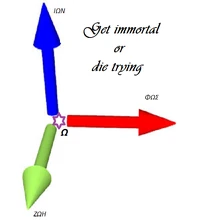Κέλτες
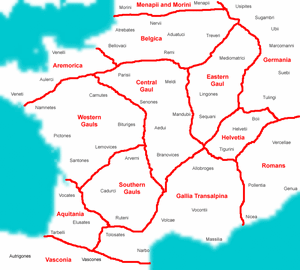
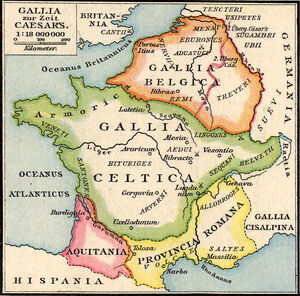
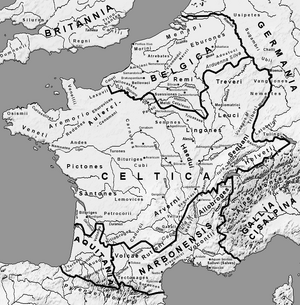
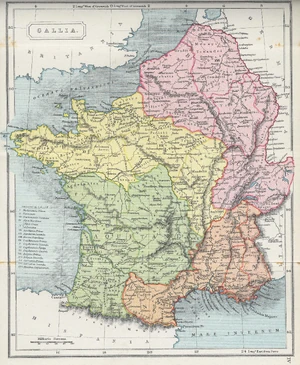
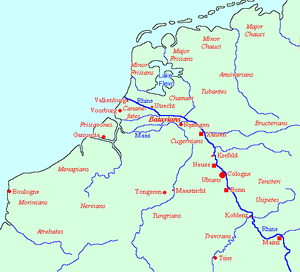
- Ιστορικός λαός της Κελτικής (και προηγουμένως της Γερμανίας).
Ετυμολογία[]
Πρότυπο:Galatia
Η ονομασία "[[]]" σχετίζεται, ενδεχομένως, ετυμολογικά με την λέξη "[[]]".
Γεωγραφία[]
The territory of the Nervii had its western and northwestern border on the Scheldt (French Escaut) river and stretched in the south through Hainaut to the forests of Arrouaise and Thiérache.
To the east, the boundaries are unclear but it is possible that they stretched as far as the Dyle river valley in the north, near Louvain, and the Meuse in the south in modern Wallonia, near Namur.
An oppidum found near Asse may have belonged to them but it was isolated and near to the territory of the Menapii.
A large population occupied the southern territories, near the river Sambre with the biggest being at Avesnelles, near Avesnes-sur-Helpe.
Caesar also mentions smaller tribes who were expected to contribute troops to Nervian forces; Levaci, Pleumoxii, Geidumni, Ceutrones, and Grudii.[1]
Ιστορία[]
Αναφέρεται από τον Στράβωνα στα "Γεωγραφικά" του.
The Nervii were one of the most powerful Belgic tribes, living in northern Gaul at the time of its conquest by Rome. Their territory corresponds to the central part of modern Belgium, including Brussels, and stretched southwards into French Hainault. During their 1st century BC Roman military campaign, Caesar's contacts among the Remi stated that the Nervii were the most warlike of the Belgae. In times of war, they were known to trek long distances to take part in battles. Being one of the distant northern Belgic tribes, with the Menapii to the west, and the Eburones to their east, they were considered by Caesar to be relatively uncorrupted by civilization.[2]
Gallic Wars[]
The Nervii were part of the Belgic alliance that resisted Julius Caesar in 57 BC. After the alliance broke up and some tribes surrendered, the Nervii, under the command of Boduognatus and aided by the Atrebates and Viromandui, came very close to defeating Caesar (the Atuatuci had also agreed to join them but did not arrive in time). In 57 BC at the battle of the Sabis (now identified as the river Selle, near modern Saulzoir; previously identified as the Sambre),[3] they concealed themselves in the forests and attacked the approaching Roman column at the river. Their attack was so quick and unexpected that some of the Romans didn't have time to take the covers off their shields or even put on their helmets. The element of surprise briefly left the Romans exposed. However Caesar grabbed a shield, made his way to the front line, and quickly organised his forces; at the same time, the commander of the tenth legion (Legio X Gemina), Titus Labienus, attacked the Nervian camp. The two legions who had been guarding the baggage train at the rear arrived and helped to turn the tide of the battle. Caesar says the Nervii were almost annihilated in the battle and is effusive in his tribute to their bravery, calling them "heroes".[4]
When Ambiorix and the Eburones rebelled in 53 BC, the remaining Nervii joined the uprising and besieged Quintus Tullius Cicero – brother of the orator – and his legion in their winter camp until they were relieved by Caesar in person.[5]
Roman period[]
The Nervian civitas was at Bagacum. The city was founded to the south of the traditional Nervian territory and is now known as Bavay. The forum has been excavated. The town was founded in c.30 BC and rapidly became a center of Roman civilization.
Towns belonging to the Nervian territory were Fanum Martis (Famars), and Geminiacum (Liberchies).
The Nervians were well known for the export of grain; an interesting tombstone of a frumentarius was excavated as far away as Nijmegen. They also produced ceramics (terra nigra).
Inscriptions found on artifacts recovered at Rough Castle Fort along the Antonine Wall across the Central Belt of Scotland indicate that in the 2nd century the fort was the base for 500 men of the Sixth Cohort of Nervii, an infantry unit. According to Tacitus, the Nervians also served in cohorts based along the Rhine border.
After the disastrous attacks by the Franks in 260-275 AD, a new chief city was designated at Camaracum (Cambrai), further south than Bavay, and Bavay itself, and the main road it was on, became part of a new secondary fortified border zone. The northern part became de-populated, and then settled by Germanic groups, leaving the southern part, medieval Hainaut, more Romanized. By 432 it seems the country of the Nervians had been taken over by the Franks.
Their king Childeric I was buried in Tournai.
The medieval Roman Catholic Archdiocese of Cambrai continued to cover the same approximate area as the Roman civitas until 1559.
Hainaut was sometimes referred to as the county of the Nervians (comitatus nerviensis) in medieval Latin, and when this came to be politically united with mainly Dutch speaking Brabant again, the counties were still distinguished in the official Latin titles (comitatus Nerviensis Bracbatensis). Today, Hainaut is divided between France and Belgium. To its north the modern Belgian provinces of Antwerp, Flemish Brabant and French-speaking Walloon Brabant approximate the rest of the old Nervian territory.
Υποσημειώσεις[]
- ↑ Wightman, Edith Mary (1985), Gallia Belgica, University of California Press, http://books.google.com/books?id=aEyS54uSj88C page 30.
- ↑ Fichtl, Stephan (1994), Les Gaulois du Nord de la Gaule, Paris
- ↑ Pierre Turquin ("La Bataille de la Selle (du Sabis) en l' An 57 avant J.-C.", Les Études Classiques 23.2 (1955), 113-156)
- ↑ Julius Caesar, Commentarii de Bello Gallico 2
- ↑ Julius Caesar, Commentarii de Bello Gallico 5.38-52
Εσωτερική Αρθρογραφία[]
- Γαλατία
- Γαλάτες
- Ιστορικές Πόλεις Γαλατίας
- Ηγεμόνες Γαλατίας
- Κελτική
- Κέλτες
Βιβλιογραφία[]
Ιστογραφία[]
- Ομώνυμο άρθρο στην Βικιπαίδεια
- Ομώνυμο άρθρο στην Livepedia
- Battle of the Sabis
- Bavay: cité gallo-romaine
|
Αν και θα βρείτε εξακριβωμένες πληροφορίες "Οι πληροφορίες αυτές μπορεί πρόσφατα Πρέπει να λάβετε υπ' όψη ότι Επίσης, |
- Μην κάνετε χρήση του περιεχομένου της παρούσας εγκυκλοπαίδειας
αν διαφωνείτε με όσα αναγράφονται σε αυτήν
- Όχι, στις διαφημίσεις που περιέχουν απαράδεκτο περιεχόμενο (άσεμνες εικόνες, ροζ αγγελίες κλπ.)
